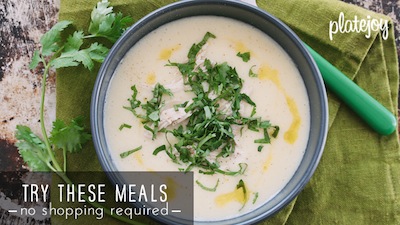
Around these parts, when you ask, you shall receive. So behold. The laminated low-sodium dining card.
It’s pretty small, a 5 by 5-inch square. Which is, of course, laminated thanks to my laminating-loving mother. It fits effortlessly into my purse or work bag. And is so greatly appreciated by kitchens across America and abroad. I have it translated in Italian, Thai, French, and Spanish for effortless travel eating.
While it clearly states the things I cannot eat–emphasizing often overlooked sodium offenders like the dreaded salt-water boil–it also importantly outlines all the ingredients the kitchen can use. This is how I not only get salt-free food, but truly fun and flavorful food. The CAN DO list gives the chef creative license to play with things like citrus, garlic, onions, wine, and even clams that we know (from cooking at home) bumps up the savory taste.
This card also makes certain that the people who need to know about your dietary limits will be well informed.
You won’t have to recite a Shakespearean monologue about your health history when you order. The waiter won’t have to play telephone to the kitchen. And the main chef won’t have to waste time asking for further clarification–or be forced to ignore the needs altogether.
You simply need to give a brief explanation of your dietary limits and hand the card over, knowing it is smooth low-sodium sailing ahead.
So go on, make your own card (with your own needs, limits, and flavor tricks), and don’t leave home without it.
With this in hand, you can live and eat on the fly more often. And be assured that your food will be salt-free and satisfying.
Chow on.
P.S. Wondering where to go out for breakfast, lunch, or dinner? I’ve just added some new LA restaurants to the Yelp! page. So click on the button to the right and check out the good salt-free eats I found!







Big fan of you and your blog. I believe we have a friend in common – Natalie Farrell. Love that girl. I’m currently dealing with Lupus Nephritis, diffuse proliferative nephritis to be exact so caught it just in the nick of time. Still in the middle of chemotherapy treatments amongst other things. Anyway, I’ve been eating low sodium during this whole thing, and I was just curious as to why you can’t have salmon? Is it really high in sodium?
Thanks for all your recipes and being awesome in general.
Mo
Thank you for sharing! And doing it so quickly i might add! This definatly gives me a good starting point to build my own card. 🙂
Thanks for the great tip on using a low sodium dining card. I usually just convey my diet needs to the wait staff with good results here in Seattle, but I think they may take me more seriously with the dining card. Thanks for sharing your knowledge!
Anxious to find out more I have liver/kidney issues
Great article and info
Oh my gosh, what a wonderful idea! I”m going to make one this morning and stick it in my purse! After receiving a diagnosis of heart failure in September at age 33 I’ve been doing well eating at home but am getting anxious to go on a date with my husband and (GASP!) eat at a restaurant. This will help us make it happen!
I think the dining card is a terrific idea. If this came into wide use the message might get across to restaurants that reducing sodium across the board should be a business goal. Almosst everyone would be healthier if they took in less sodium.
This is a fantastic idea. I was diagnosed last February with CKD stage 3. Both of my kidneys are affected and they both have AML’s. I’m still learning what I can have and what I can’t. So far I’ve been told to watch my potassium and that I need more Vitamin D. So per my nephrologist I’m taking a Vitamin D3 supplement and drinking Vitamin D milk. Any suggestions. I am 46 years old.
My 12 year old daughter was diagnosed this month with Stage 3 Kidney Disease. I can not wait to get home tonight and show her your blog! Eating out is…was…her favorite thing. I think your tips will show her it can be done!